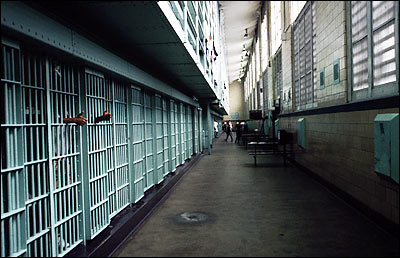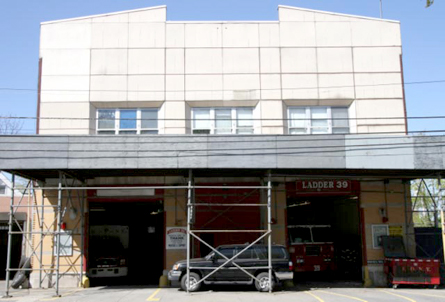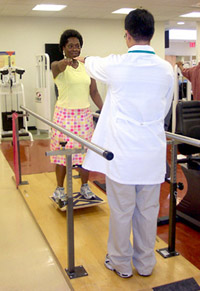
There were almost 900 patients waiting for care in hospital hallways or emergency rooms at one point in 1990 because the city's hospitals had more patients than they had beds for. Doctors said that hundreds more people avoided treatment altogether, knowing there was no room for them.
This was medical care during the height of the AIDS and crack epidemics.
Just four years earlier, though, the experts were saying that New York City's health care system was far too large. In 1986 a federally appointed panel said one in every seven hospital beds was unnecessary, and described any plan to expand or renovate a hospital as "outdated and probably unacceptable, whether it had been approved or not."
Obviously, the members did not know what lay ahead. But could they have? Should hospitals have planned differently? For that matter, how does anyone prepare for a future that is impossible to predict with certainty?
Strange, sometimes inexplicable, things are happening across the city. Crime rates are falling, yet the number of prisoners in city jails goes up. Public school enrollment has been dropping for years, yet many schools are increasingly overcrowded. “New York Is Losing People At Fastest Pace in America”, a newspaper headline screamed last week. But the city's population is at an all-time high.
There are different techniques for making sense of all this. To determine where to build or close fire stations, the city employs its own “complicated” but “non-mathematical” (and, critics charge, blatantly political) formula. To determine where it needs to build schools, it employs Eunice and George Grier, a husband-and-wife demography team working out of their home in suburban Maryland.
Those who run jails and hospitals have their own methods for predicting future needs, but their actions show how much faith they have in them. For years, the city has kept two empty jails around, just in case, and hospitals get nervous whenever more than 80 percent of their beds are full.
"You have to be respectful of the unforeseen," said Jim Tallon of the United Hospital Fund, acknowledging that the crack and AIDS epidemics developed "right under our noses" when he was head of the state assembly's health committee in the 1980s. "Things can occur that [you] didn't see coming."
JAILS: SETTING SPACE ASIDE
Between 1991 and 2004, the number of inmates in New York City jails dropped from 22,600 to 14,500, reflecting the monumental drop in crime throughout the city. The city, which was also facing budget problems, decided that it could get by with fewer jails.
"It didn't make financial sense to run your smaller operations at less than full strength when you have the ability to absorb that population into your main component," said Tom Antenen, a spokesperson for the Department of Corrections.
So the city closed three jails – one each in Brooklyn, the Bronx and Queens – and concentrated prisoners on Rikers Island. (A jail in downtown Manhattan and another in a barge docked in the Bronx remained open). Today almost nine of every ten inmates in the city are locked up on Rikers.
Keeping inmates together in one place allows for economies of scale, the city says. Also, because Rikers Island is so isolated, some of the inevitable conflicts with neighbors unhappy about living near a jail are avoided.

But there are costs as well. People generally appear in court in the borough where they were arrested. In addition, some attorneys are reluctant to make inconvenient trips to Rikers, so the city also brings inmates to courthouses to meet with them. Every year, city vans carry inmates to court dates and other appointments around the city. The cost, said the city's Department of Corrections, has gotten significant.
"We achieved some gains," said Antenen, but now the city makes tens of thousands of trips between Rikers and courthouses around the city. "That is an extra load we have to carry because we don’t have the borough jails."
There is some flexibility built into the jail system to account for predictable seasonal shifts (more people get arrested in good weather than bad, when they tend to stay inside and out of trouble). The city's Department of Corrections also predicts trends from year to year by examining crime rates, police arrest strategies, and the balance of felonies to misdemeanors (felonies take longer to process, so more felonies translates into a greater need for space) to predict its need for future space.
Crime rates are staying low, but lately there has been a spike in the number of inmates in city jails. Experts say the weather, while quite nice, cannot be completely to blame. Like many criminal justice-related trends, the spike in inmates is somewhat of a mystery.
Planning for such an event, the city has kept space in several empty jails warehoused, the largest being the 800-person Brooklyn House of Detention on Atlantic Avenue. Keepign reserve jail space is common for cities "hedging their bets", said Robert Gangi of the Correctional Association of New York State, a prisoner advocacy group.
But doing so isn't popular. Even though the city bore little direct financial cost from keeping the Brooklyn jail empty, community activists and local elected officials protested throughout its hibernation. They complained that the city was wasting money by renovating it, and depriving the community of a potentially valuable piece of real estate.
Now the Brooklyn jail may be reopened, as part of a plan that Mayor Bloomberg has described as a way to "share the pain", shifting back away from the supposed efficiency of keeping almost everyone at Rikers. People may not like it, but the city says the only thing that needs to be done to prepare the empty jail is to give it a good cleaning.
SCHOOLS: IGNORING THE SIGNS?
 From their home in suburban Maryland, Eunice and George Grier examine birth statistics from the city's Department of Health, analyze immigration trends, and track school enrollment for several different ethnic groups in each school district. For well over a decade, the city has contracted the husband-and-wife demography team to track long-term enrollment trends. The journal School Planning and Management recently praised the Griers for being "extraordinarily accurate."
From their home in suburban Maryland, Eunice and George Grier examine birth statistics from the city's Department of Health, analyze immigration trends, and track school enrollment for several different ethnic groups in each school district. For well over a decade, the city has contracted the husband-and-wife demography team to track long-term enrollment trends. The journal School Planning and Management recently praised the Griers for being "extraordinarily accurate."
Due to the end of the "baby boom echo" and a slowdown in immigration, New York City schools will have 110,000 fewer students by 2014, predict the Griers (in pdf format). The slowdown, which has been going on for several years, is only the latest turn in a series of rises and falls throughout the history of the city's schools.
New students poured into the system as the baby boomers began attending school in the 1950s, but enrollment then dropped for most of the 1970s and early 1980s as many parents moved out of the struggling city. After hitting a low in the early eighties, there was sustained growth until 2000, spurred first by the children of baby boomers, and then by those of new immigrants.
While the broad outlines of these trends are identifiable, predicting their twists and turns is hardly an exact science. In the late 1990s, the Griers were predicting that enrollment would begin dropping, but not until 2002. Between 2000 and 2002, they said, enrollment would increase by 6,000 students. But the downturn came in 2000, and over the next two years school rolls shrank by 10,000 students.
The New York City schools are particularly challenging for demographers, say the Griers, because of its size and because enrollment is tied closely to immigration, which is hard to project because it is affected by future federal policies and turmoil in foreign countries. The city's new focus on charter schools, which don't have to report demographic data as thoroughly, they say, is an added challenge.
But effective planning depends not only on what is happening in the school system as a whole, but what is happening in individual neighborhoods around the city. While enrollment numbers are dropping citywide, some areas – like Lower Manhattan and the Upper East Side – are actually expected to see their numbers rise.
For obvious reasons, neighborhoods don't want to hear they are losing students. Some local public officials criticize the Griers predictions of decline in neighborhoods like Fort Greene, Williamsburg and Greenpoint, citing plans for large-scale residential development. The Griers respond by saying that the impact of developments like the Atlantic Yards project are too uncertain to be taken into account today because they are still subject to major changes due to the political process. Until more is known about such developments, they say, it is unclear how many of the new developments' residents will attend public school.
Planning and Politics
"We don't get involved with policy, and we shouldn't," said George Grier. "That's for the politicians."
Of course, officials take more into account than the sober predictions of demographers when forming school policy.
To date, say experts, New York City has failed to provide adequate capacity in its school system. Three out of four high school students attended overcrowded schools in the 2002/2003 school year, according to a report by the Independent Budget Office. The city's recent focus on small schools exacerbates this problem, some say, because it means using scarce space in public school buildings to serve a relatively small number of students.
Lowered enrollment gives the city the opportunity to catch up, said the Independent Budget Office.
Noreen Connell of the Education Priorities Panel says the city has a series of tools at its disposal to confront overcrowding. Most obviously, it could build new schools. But shifting the borders of school districts or lease existing space could be cheaper ways to do the same thing.
The failure to implement such solutions, say city officials and education advocates, is based largely on the lack of funding from Albany. This has been the subject of the long-running Campaign for Fiscal Equity lawsuit. In February, the mayor said that the goals of the current capital plan would not be met if Albany didn't pitch in.
The state has been resistant to increasing funding to city schools, even after courts have ruled that it must. But as part of this year's budget, Albany laid out a five-year plan to dedicate $11 billion for school construction, the Campaign for Fiscal Equity's estimated amount of how much it would cost for New York City to build the schools it needs.
With the resources suddenly available, the city has the freedom to make decisions on planning based more on what the system actually needs, say advocates, but it needs to step up and do so.
"They need a long term plan to create the capacity so that all the kids in New York City can go to uncrowded schools with smaller classes," said said Leonie Haimson of Class Size Matters. "They actually have the potential to do this." [Read this week's Commentary, "Keeping Classes Large" by Leonie Haimson for more]
THE FIRE DEPARTMENT: ADJUSTING TO A CHANGING JOB
Facing a budget squeeze in 2003, the mayor's office used a "complex" but "not mathematical" formula that took into account response times to fires, population density, and the locations of firehouses around the city. It determined that it could close six firehouses – four in Brooklyn, one in Manhattan, and one in Queens – without harming fire department's ability to do its job.
Three years later, the time it takes the department to respond to fires has increased, even as the closings have not allowed the department to cut costs (in pdf format). But even many critics of the closings agreed that the fire department needed to be restructured accordingly. So what went wrong?
It is true that in some ways the job of the fire department is getting easier. Despite a growing population, New York has fewer fires (in pdf format). Sprinklers and better fireproofing have made buildings safer. And the city has developed more efficient ways to deploy fire trucks to emergencies around the city.
What has changed is what kinds of emergencies those trucks are being sent to, and critics say that the city failed to take into account what the fire department actually does. While the fire department may respond to fewer fires, it has an increasing amount of other duties, including providing emergency medical services, clearing sites of hazardous materials, and investigating carbon monoxide alerts.
But when the city studies its capacity, it relies on data collected in the 1970s when fighting fires was still the major task of the department, said Vincent Dunn, a retired deputy fire chief. It doesn't look at the department's other tasks. Dunn and others, like the Citizens Budget Commission, which studied the department extensively in the 1990s, say the city needs to review the way it looks at response times in a way that takes the changing nature of firefighting into account.
"It's not your grandfather's fire department anymore," said Charles Brecher of the Citizens Budget Commission.
The city's approach has allowed it to improve its performance in some places. Rapidly growing Staten Island was suffering from the biggest slowdown in fire response until 2004, when a new fire station and emergency medical service station was built. Since then, Staten Island has been the only borough to see reduced fire response times.

Woodlawn firehouse (photo by Susan Sipprelle)
Meanwhile, the city recently announced plans to close another fire station – the Woodlawn firehouse in the Bronx. Jeff Klein, the local state senator who has studied how closings have affected response times citywide (in pdf format), complains that the city continues to use flawed analysis to determine which areas can get by with fewer fire stations.
"The money saved means nothing compared to the lives lost," he said.
HOSPITALS: PLANNING FOR THE UNPREDICTABLE
There is currently a good deal of momentum to restructure the health care system in New York State, a process that state officials and hospital industry groups agree may include closing hospitals. A state commission has been appointed to look into "right-sizing" the health care system, which is seen to be in bad shape financially.
Some worry, however, that these discussions are neglecting the health care system's ability to respond to future disasters.
"I don't think it's a different situation now [than in the mid-1980s]," said Judy Wessler of the Commission on the Public Health System, a group opposing hospital closings. Shutting down hospitals, she said, "will totally throw out our ability to deal with any surge capacity or need."
Surge capacity refers to a hospital's ability to respond to sudden increases in the need for medical attention. It may include quickly providing extra bed space, bringing on extra staff, discharging current patients to accommodate new ones, or even setting up temporary wards to handle large numbers of ill or injured people. Plans generally include cooperation between competing hospitals.
Some surges, like flu season, are somewhat predictable. For day-to-day planning said Tallon of the United Hospital Fund, hospitals try to stay between 75 and 80 percent capacity. New York hospitals operate within that range he said, but they are running significantly closer to capacity now than they were two years ago.
 Other surges, like hurricanes or terrorist attacks, are not predictable.
Other surges, like hurricanes or terrorist attacks, are not predictable.
Concerns about dealing with these kinds of disasters have always been around, but have been increased by 9/11, the failure of the response to Hurricane Katrina, and continued fears about bio-terrorism and bird flu. Some see surge capacity around the country as inadequate.
New York's health care system does have plans for future disasters. In order to get federal funding, the state meets requirements to be prepared to accommodate a surge of 500 patients for every million in population within three hours. About 75 percent of the state's hospitals say they have specific plans to deal with bio-terrorism (in pdf format).
Reserving the capability to respond to large-scale disasters is expensive, and the financial viability of the health care system in its current form in question. Currently, there is a debate among the Commission on Health Care Facilities, the panel looking to "right size" the state's health care, and health care advocates about how much extra space the system has – and how to reserve the surge capacity it needs.
"It is not possible to have the beds, staff and equipment in place at all times to meet the most extraordinary demands that are every likely to face the system," the commission wrote in a report published in February.
It is unclear how the commission is considering surge capacity among its priorities, but groups like the Healthcare Association of New York State have expressed concern.
"How can we balance our ability to deal with the potential disaster versus the state's ability financially to run the system on a daily basis," said William Van Slyke of the Healthcare Association of New York State. "That's a tough thing."
Susan Sipprelle contributed to this article.Â




